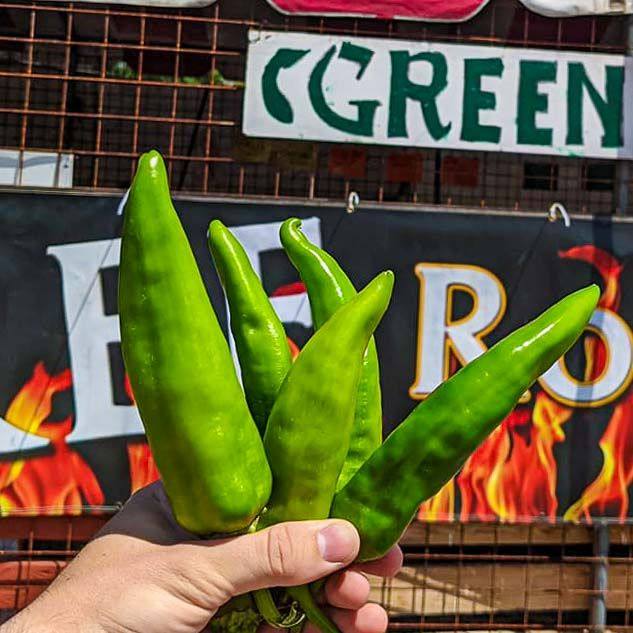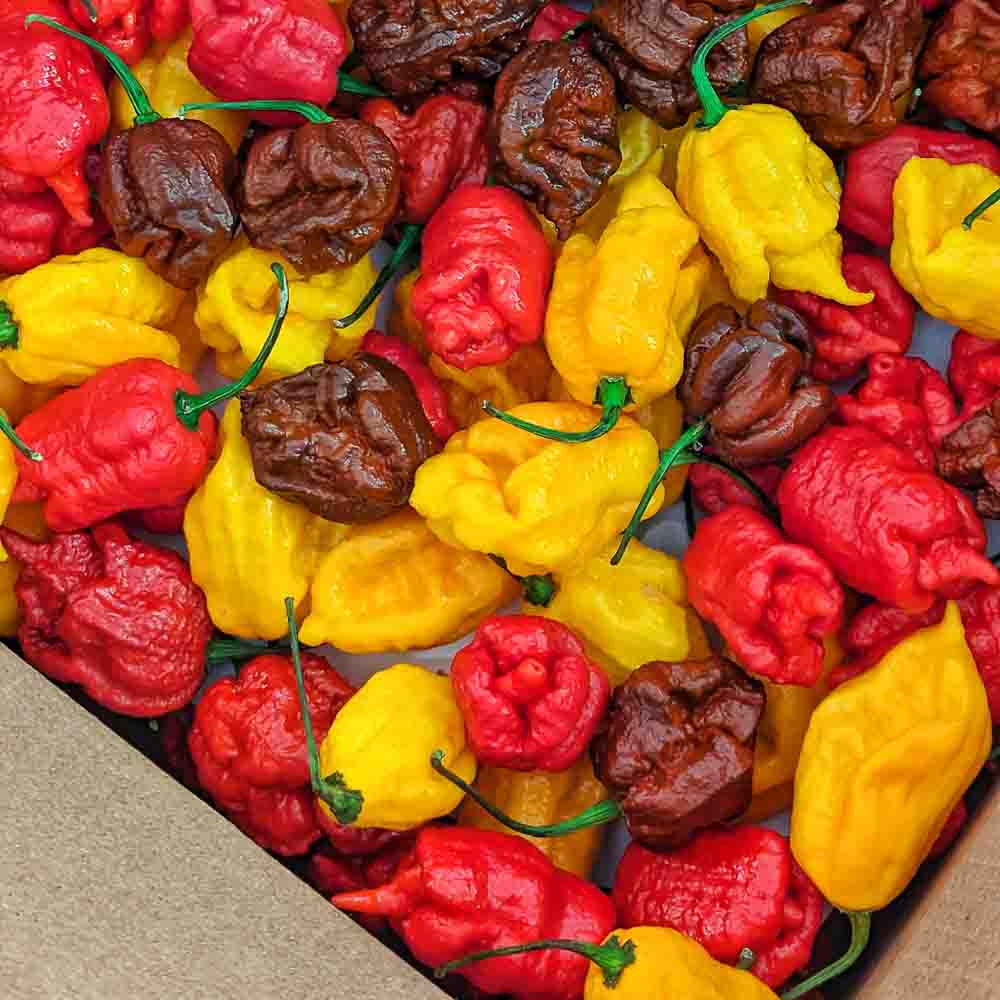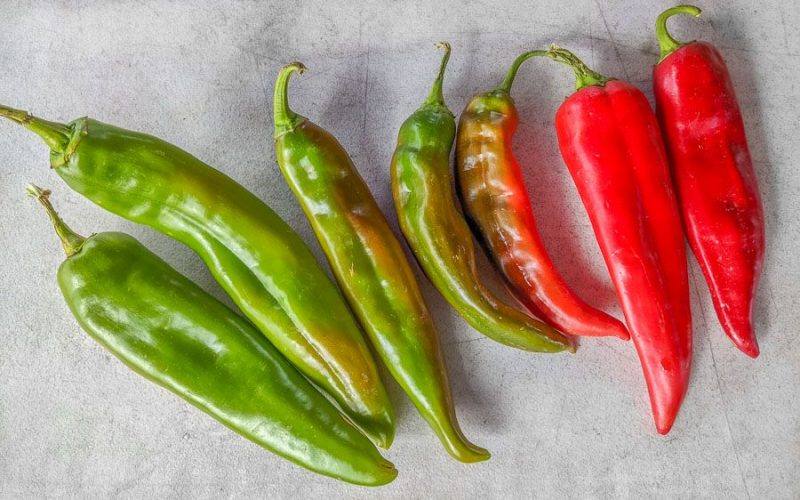Many types of New Mexico chile
Although we sell green chile by temperature, Mild, Medium, Hot, Extra Hot, XXX-hot, etc, the differences between New Mexico chile varieties run deeper than that.
Chile has been a big thing in New Mexico for a long time, and as a result, many different varieties exist. Many are bred for their size and meatiness, such as Big Jim. Some are bred to bring the heat, like Lumbre. Some chile is bred to mass produce, like Arizona 88. We don’t sell that one, as it is an inferior product, but most giant grocery stores do. Everyone has something different they look for in New Mexico chile, and that is why we let people see and try the chile before they buy. It is important for us to make sure you have the best possible chile experience.
The purpose of Different chile
Every chile serves a purpose, which includes much more than simply heat level. For our hot green chile, we generally get Miss Junie. Our ristras are made with Sandia, a chile variety developed by Roy Harper in 1956. Both are a solid “hot” temperature, but the Miss Junie a is slightly spicier, more meaty variety, which means it will roast better. Sandia is less so, which leads to better drying.
There are many different things that consumers look for in chile. Sometimes they need chile that is long and straight, so they can make chile rellenos. Big Jim, a cultivar developed by Roy Nakayama in the 1970s is typically the best for this. The mild 1904 and 6-4 varieties also work, as well as the hot Miss Junie.
Sometimes, people want as hot as possible. Traditionally, Barker was the choice for spice-lords, but Lumbre has overtaken its throne in recent years. Barker remains as the primary extra hot variety at Farmers Chile Market and most other chile stores. Lumbre is our XXX-hot variety.
The original New Mexico chile pepper was Numex No. 9, developed and released by Fabian Garcia a little over 100 years ago. Although it is not as common as other famous varieties of New Mexico chile in modern times, its purpose as the forefather of Hatch chile will always be significant.
Differences in the same varieties
Red or Green?
Red chile and green chile is another factor which is important. Green chiles have many differences with red. Red fruits are more mature, with a lot more sugar. They take longer to roast, and the peel is more resilient. They also dry much better, and hold their shape well, where green typically shrivels and doesn’t look great.
Red Chile
New Mexico chile typically ripens up to become red chile. Fresh red chile is quite sweet, but most people don’t eat it when it is fresh. Instead, most red chile is sun dried. These sun dried red chile pods are then ground into red chile powder by processors in Hatch New Mexico, or sold to consumers as whole chile pods. These pods are the base of New Mexico’s mother sauce, the red chile sauce. The arrival of fresh red chile is also a big milestone in the chile season, as it means that chile ristras are available. Although ristras are often used as just a decoration, they are also edible if they are untreated, and many fantastic chile sauces are made with chile ristras!
Green Chile
The arrival of green chile marks the beginning of what people refer to as the chile season, which typically goes from the start of August to nearly the end of October. Green chile is almost exclusively roasted and peeled before eating, but green chile powder has also become more and more popular in recent years. After roasting, it is typically bagged up in freezer bags and frozen for consumption at a later date. Chile Pasado is another way to preserve roasted green chile by drying it. Green chile is much less sweet than red chile, and I would argue that its flavor is somewhat more grassy and herbal than red. Due to it needing to be roasted to peel it off, I recommend finding a good chile roaster, or reading our guide to roasting green chile!
Common New Mexico Chile Varieties
Mild Chile Types
There are many chile varieties such as R Naky which are primarily grown as paprika type chile, and not meant to be roasted. As we are a chile roaster, we will primarily focus on chile commonly used in roasting or making New Mexican food.
New Mexico 6-4
This variety was developed as a team effort at NMSU based on Numex No 6, which was released by Dr. Roy Harper back in the 1940s. In Modern times, the NuMex Heritage 6-4 variety has become more common. It’s heat level is typically around 1,500 Scoville Heat Units, SHU or less.
NuMex Joe E. Parker
Another mild variety which was released in 1990, this chile is typically around 1,000 SHU.
Medium Chile Types
Big Jim Chile
The Big Jim chile variety was developed by Dr Roy Nakayama in the 1970s at NMSU in collaboration with famed chile farmer “Big Jim Lytle”. This chile went on to be labelled by Guinness as the world’s largest chile pepper. Possessing a medium heat, this is by far the best chile variety to be used for chile rellenos! In modern times, NuMex Heritage Big Jim has become more common. Big Jim is somewhat notorious for being a bit inconsistent in heat level, with some peppers being rather mild, while others are up to 9,000 SHU. Along with something I like to call “spiceflation,” or the perceived heat level going down as people desensitize themselves with hotter and hotter chile, more and more people are regarding Big Jim as Mild. We still classify it as medium, because it has been for the past 50 years. Maybe we will change this at some point, but we also have a long history and want to respect our New Mexico traditions!
Hot Chile Types
Sandia Chile
This is the traditional “hot” New Mexico chile, and has been since it was release in the 1956 by Dr. Roy Harper. Sandia is the primary chile used to make red chile ristras in New Mexico. A more modern version of Sandia, known as Sandia Select is also a great chile for roasting, as it is bigger and thicker.
Ms Junie
This relatively new chile variety was developed by Solar Dry Chile in Hatch. Named after the late, June Louise Franzoy Lytle Rutherford, this chile is somewhere between Big Jim and Sandia in size, while also being hotter than Sandia too! Although some chile vendors will mark this as an extra hot chile, it still is lighter in heat level than a Barker variety. Miss Junie is an amazing chile for roasting as it is big, thick, and juicy! It even works great in chile rellenos too. One major downside to it, is that because it is so juicy, it doesn’t dry as well in the sun. This is why ristras are usually made with Sandia chile over Ms Junie still.
Extra Hot Chile Types
Barker Chile
Barker chile has been the typical extra hot variety in New Mexico for as long as I can remember. It is quite a bit smaller than either Sandia or Miss Junie, but is almost always a decent amount spicier than either. Barker is more difficult to roast than other varieties of chile, as it is more prone to burning. It is not as juicy as many types of chile, so a roaster needs to pay attention when roasting this variety.
Hotter than Extra-Hot Types
Lumbre Chile
As of now, the most consistently hot New Mexico chile variety I know of is the Lumbre chile. It was developed in recent years by Jimmy Lyttle, son of “Big Jim” Lyttle. This veins of this chile are yellow, orange, and red, which should frighten you if you are afraid of spice. When we roast this chile, even the air around the roaster becomes spicy. We call this chile XXX-hot, because it is dangerous how spicy it is. Although it won’t be too hot for someone who eats ghost peppers like candy, when you eat a dish with a green chile sauce made of lumbre chile, you will feel the heat! We also try to carry this in dried red chile pods, but it often sells out within a day or two. If you see lumbre red chile pods, buy them right away!

Other types of chili Peppers
Superhot Chili Peppers
Superhot chilies are a new trend in chili pepper cultivation. twenty five years ago, the hottest peppers you might find would be things like habanero and scotch bonnets. Although the red savina pepper was the hottest in the world, few people really knew much about it at the time. The first superhot pepper to really kick off the modern spice craze was the bhut jolokia, or ghost pepper as it is most commonly known. Dr Paul Bosland of NMSU’s Chile Pepper Institute said this pepper “kind of opened the floodgates.”
Since then, other peppers emerged, with a new one taking the crown every year or two. Trinidad moruga scorpions were the top dog until they got overturned by the Carolina Reaper, which as just recently been overtaken by Pepper X. The amount of superhot chile varieties available now is immense, with tons of growers and researchers trying to make their own mark. One popular chile variety is the 7 pot, which has many different strains. You might have heard about a California reaper, which is a yellow version of the red Carolina reaper.

New hottest peppers
Although unconfirmed by Guinness, there are some new peppers that are rumored to be even spicier than the Carolina Reaper. If you ever hear of Dragons Breath or Pepper X, be prepared, as they are supposedly much hotter than even the Carolina Reaper. These new chile peppers are pure fire.
Sweet peppers
Along with a boom in superhots came a boom in the sweet pepper department as well. For decades, you could find a few colors of bell peppers at any old grocery store. These mild peppers give a good flavor and juiciness to any dish they are in, along with tons of health benefits. There are a lot of different sweet peppers available, such as the Corno di Toro. The Hamik pepper is one of the sweetest peppers you can find, with sweetness that makes it comparable to many fruits.
Famous peppers around the world
Many countries have their own chile traditions and cultures, just like us in New Mexico. In Japan, their most famous chile is the shishito pepper, which goes really great flame roasted and paired with beer. It is a very common bar food in Japan. In southeast Asia, the Thai or birds eye pepper reigns supreme, but stroll down any market, and you will see tons of different types of chile that you can never find in the US. If you get pho in the US, it typically has jalapenos, but in Vietnam, it typically comes with a local green chili and lime wedges. Mexico, has some of the most famous chile varieties in the US, so we have an entire post about different types of Mexican chile peppers!
India and Sri Lanka are famous for spicy food, which explains why the ghost pepper and naga chile varieties came from there. Trinidad is also quite famous for both the Trinidad Scorpion and the 7 pot varieties of chile. Cayenne pepper is another super famous pepper, and arguably the most used for spice powder which adds heat. Paprika is of course more common, but mild.
The world is a big place, and although I do consider myself a chile expert, my field is primarily related to chile in New Mexico. Because of that, I can’t list off every single pepper, but I can say that the amount of different pepper cultivars is simply astonishing. You will find different chile everywhere you go, as long as the cuisine is one that appreciates spice.
New Mexican Spice
Although there are many different types of chile peppers in the world, New Mexico is unique in a major way. We eat chile with literally everything. In a day, you might have three different meals and a snack, all containing chile. Whether it is green chile scrambled eggs for breakfast, a chile cheeseburger for lunch, some red chile beef jerky for a snack, or something else, we eat more chile than anywhere. Hatch is the Chile Capital of the World, but we love our chile everywhere in New Mexico. In fact, we love it so much, that even our neighbors can’t resist! Chile roasting season is a very important thing for us in New Mexico. It is especially important to us at Farmers Chile Market. We hope to be your destination to get your roasted chile in 2024!

